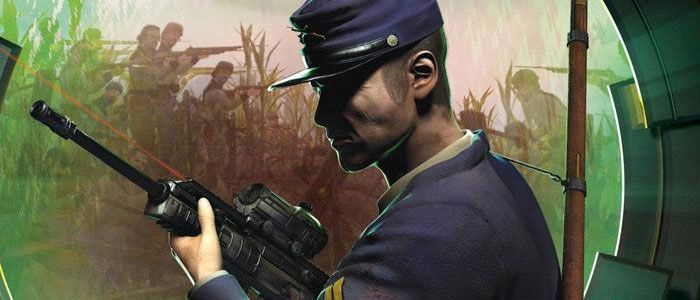Darkest of Days may be the FPS that ruined all FPSs for me. The game sends you through time to participate in history’s greatest battles, but the bland graphics, the cretinous AI, the dull, dull action reduce every scene to the same muddy, floaty, frustrating shoot-out; if you squint, there’s nothing to distinguish one level from the last. The tedium is pervasive. It makes killing people such a struggle that I began to question whether it is fun to kill people at all. Probably because I played this just after slogging through that epitome of mediocrity, Wolfenstein, but I was rocked to the core by this existential doubt: if I don’t enjoy killing people, then what is there to modern gaming? Suddenly I was deeply bored, frustrated, even annoyed by the entire FPS genre. I never wanted to kill a virtual person again. Darkest of Days did this to me.
The plot is intriguing; at least, the plot as described in a press release is intriguing. In execution it is messy and mangled. Chronotech, some future corporation, nabs people from history and turns them into time-traveling soldiers to defend the continuity of the timestream. The plot sounds like a great excuse to put you through a bunch of battles from the broad spectrum of history, but it’s full of holes, which happens when writers mess with time travel. Why grab people from pre-modern eras, when they didn’t even have the concept of time travel, rather than train soldiers from the future? And if we’re fighting to keep the past from being changed – well, technically, the past could have been changed already and we never would have known because it’s in the past.
Ignoring all this takes some work, but it can be done. But ignoring the gameplay is like ignoring barbecue forks rammed in your eyes. The action plays like an ersatz Call of Duty – same damage system, same grenade indicator, same aiming down the sights – but without CoD’s tightness or… competence. Aiming is slow, melee hits don’t seem to connect, and jumping is like surfing on a Lakitu cloud. Battles often break down into confusing individual shootouts that lapse into random melee; there’s no sense of tension, no sense of being part of an army. The friendly AI ignores you altogether; the enemy AI might deign to shoot at you every once in a while, though more often they prefer to stare into space or get stuck on scenery, waiting for you to put them out of their misery. Then they flop over backward into classic broken-spine ragdoll postures, their inarticulate mouths gaping at the sky, seeming to demand, “Why, 8monkey Labs, why?”
The premise hamstrings the game. The Civil War to the First World War are rarely mined for games, let alone FPS games, for the probable reason that primitive single-shot rifles are not fun to use. You fire your black powder musket and watch a frantic animation of your guy reloading. You can hit a button at the right time, Gears of War-style, to speed this torture, but if you miss, and you will, you are punished for your mistake by a jam. And this happens after every shot in the Civil War levels. I propose that it is only with the advent of automatic weaponry that it has become fun to gun down people.
The levels are large, but there is zero freedom. If you’d like to circle the Confederate or Roman or German camp and ambush them from high ground rather than charge in the front, well, you can just go to hell, sir! Darkest of Days wants you to play the levels their way, and they’ve put plenty of invisible walls in place to ensure you do. The walls may keep you from swimming across a pond or walking down a hill, or they may be random, in the middle of a forest or field. I prefer to think that the wily folk at 8monkey Labs have designed this as a sort of Skinner box, and they are watching you play through the game, recording your reactions to arbitrary punishment and rewards, forming some dark hypothesis as to the durability of the human psyche. Certainly they didn’t put in the invisible walls to cover poor design. In 2009, that is a capital offense.
There is also the karmic explanation for the game, that it is a punishment inflicted upon you for past sins. That would explain the graphics. The game uses the proprietary Marmoset Engine, a groundbreaking piece of technology for 2003; it crafts characters as incredibly lifelike as Team America’s puppets, and almost as well animated. The mountains and hills would be quite stunning on the Nintendo 64. I applaud the bold artistic decision to eschew natural rounded edges to bodies of water in favor of sharp angles. Granted, the water is nicely reflective, and running through a cornfield was almost as well done as in this summer’s Call of Juarez. Too bad this illusion is shattered the moment you see a soldier skating around as if his shoes are soled with slabs of lard.
What makes this all so frustrating is the game’s commitment to military history. I consider myself a military history buff and was eager to experience these battles. The game also throws little factoids at you during the loading screens, and the weapons are supposed to be accurate. (Until they hand you a laser rifle, anyway.) But it is all so poorly realized, wrapped up in such a clumsily produced game, that these enticements just add to the frustration. If you’re curious about history’s greatest battles, go read a book. Darkest of Days will not only not make you smarter, it will actually strangle your brain cells. You could play this game, or drink a gallon of turpentine. I choose the turpentine.
